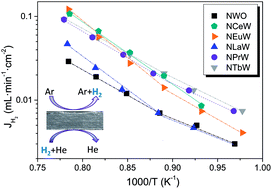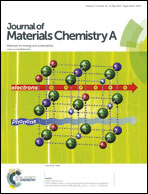Optimization of the mixed protonic–electronic conducting materials based on (Nd5/6Ln1/6)5.5WO11.25−δ†
Abstract
The tungstates Ln6WO12 are proton conducting materials exhibiting mixed (protonic and electronic) conductivity and remarkable stability in moist CO2 environments. Hydrogen-permeable membranes made of this kind of material find application in industrial gas separations such as hydrogen separation from hydrogen containing gases, for the implementation of pre-combustion strategies in fossil-fuel power plants and catalytic membrane reactors. This work presents a thorough characterization (structure, conduction and hydrogen permeation) of mixed conducting materials on the specific system (Nd5/6Ln1/6)5.5WO11.25−δ (Ln: La, Ce, Pr, Eu, Tb). The evolution of the crystal structure and crystallite size was studied as a function of the lanthanide dopant. The total conductivity in different environments was investigated as a function of pO2 and temperature. Furthermore, the H/D isotopic effect and the hydration effect were also studied in reducing and oxidizing atmospheres by DC conductivity measurements. Hydrogen permeation was measured for all compounds in the range of 700–1000 °C studying the effect of pH2 and the hydration degree of the membrane depending on the lanthanide dopant. Finally, the chemical stability of these materials at 800 °C was evaluated in contact with a humidified CO2-rich gas stream.


 Please wait while we load your content...
Please wait while we load your content...